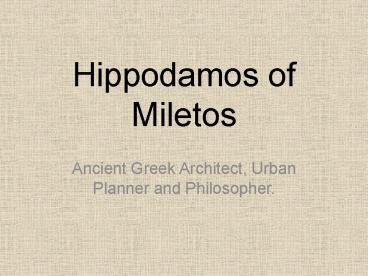Hippodamos of Miletos - PowerPoint PPT Presentation
1 / 15
Title:
Hippodamos of Miletos
Description:
There were several urban planners prior to Hippodamus, but we only know some names. ... Citizens were divided into three categories; Farmer, artesian and solder ... – PowerPoint PPT presentation
Number of Views:1236
Avg rating:5.0/5.0
Title: Hippodamos of Miletos
1
Hippodamos of Miletos
- Ancient Greek Architect, Urban Planner and
Philosopher.
2
Urban planning pre-hippodamus
- There were several urban planners prior to
Hippodamus, but we only know some names. - Hippodamus and Plato, both being urban planners
were late in the game, yet the best documented. - Hippodamus, inventor of gridiron plan?
3
History of Greek cities.
- Cities were constantly being founded, destroyed,
expanded, relocated and re-built. - Presumably, by the 4th century B.C. 1/3 of all
cities had been newly founded since the 8th cent.
B.C.E - The development of the polis as a
characteristically Greek institution relates to
the re-design of a city.
4
Hippodamus Overview
- He was not a politician
- Saw city planning from the theoretical side,
rather than the practical side of things - He was concerned not solely with the physical
layout of cities, but in the ordering of an ideal
society. - Planned several cities that we know of,
influenced many.
5
Hippodamian Theory
- Hipodamus was a philosopher.
- We know few details of his full ideal, but based
on what he proposed and created at other sites,
we get the idea - Tripartite system
- Citizens were divided into three categories
Farmer, artesian and solder - Land was to be divided into three parts equally
one for public use, private use and religious
use. - Aristotle credits him with the discovery of the
poleis (polis)
6
Miletus
- An ancient city, in its archaic form it was
irregularly built. - Was invaded by the Persians in 494 B.C.E
- Returning survivors planned a new modern city
- Rectangular networks of streets.
7
Modern Miletus
- After the Persian invasion, this grid-iron was
created. - It is debatable whether or not Hippodamus
invented the layout. - Although it is certian he was definitley
influenced by it.
8
Miletus v.s. Athens
9
Priene
- Ancient city of up to 5,000 inhabitiants.
- 16 miles north of Miletus
- Originally on the sea coast, now a steep terrain
10
Priene
11
Ancient Priene
- Agora
- Stadium
- Theatre
- Main streets
- Temple
- Insulae
12
Priene
- Fortified and built in to the southern slope of a
large hill - Streets traveling east to west were level, while
the north to south streets were steep
13
Piraeus
- 9 miles S.W. of Athens
- Has been inhabited since the 26th century B.C.
- Because of its seaside location, Piraeus
harbors were used by - the Athenians as a prosperous shipyard,
eventually the town was - fortified and began to grow.
- Hippodamus came in around
- the 5th century B.C.E to arrange
- the growing city.
- Boundary stones Nemeses
14
Hippodamus
- Inventor of the gird layout.
- Greek emphasis on individual glory
- Major contributions to the world or urban planning
15
Hippodamus
- Richard Tomlinson From Mycenae to Constantinople.
Pgs. 56, 70-75 - Ferdinando Castagnoli Orthogonal Town Planning in
Antiquity. Pgs. 10, 1297-102 - Nicholas Cahill, Household and City Organization
at Olynthus. Pgs 37-42





























